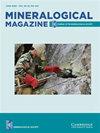Mineral chemistry and genesis of monazite-(Sm) and monazite-(Nd) from the Blue Beryl Dyke of the Julianna pegmatite system at Piława Górna, Lower Silesia, Poland
IF 1.4
3区 地球科学
Q2 MINERALOGY
引用次数: 0
Abstract
Abstract Monazites are one of the most interesting groups of accessory mineral components of crystalline rocks due to the information on geochemical evolution of the crystallisation environment coded in their chemical compositions, in addition to comprising one of the most valuable objects for geochronology studies. This paper presents monazite-(Sm) and monazite-(Nd) from the Blue Beryl Dyke of the Julianna system of rare-element pegmatites at Piława Górna, Lower Silesia, Poland. These monazites are unique due to their unusually high Sm and Nd contents, reaching 33.22 wt.% Sm2O3 and 34.12 wt.% Nd2O3, respectively. We consider the most significant factors of the enrichment in Sm and Nd to be the occurrence of highly fractionated pegmatite-forming melts during the final stages of solidification and associated hydrothermal fluids that were strongly enriched in rare earth element REE–Cl and REE–F complexes. Local disequilibria allowed for the rapid growth of accessory phases under supercooling conditions associated with the scavenging of selected elements, leading to their local depletion, which was not balanced by diffusion processes. As a consequence, the depletion of light rare earth elements (LREE) led to the incorporation of available middle rare earth elements (MREE, Sm–Dy) in the case of Sm and Nd, which could occupy an acceptable structural position in minerals of the monazite group.波兰下西里西亚Piława Górna Julianna伟晶岩系蓝绿柱石脉中独居石(Sm)和独居石-(Nd)的矿物化学和成因
摘要独居石是结晶岩中最有趣的副矿物组分之一,因为其化学成分编码了结晶环境的地球化学演化信息,此外还构成了地质年代研究最有价值的对象之一。本文介绍了波兰下西里西亚Piława Górna的Julianna稀有元素伟晶岩系蓝Beryl岩脉中的独居石-(Sm)和独居岩-(Nd)。这些独居石是独特的,因为它们的Sm和Nd含量异常高,分别达到33.22 wt.%Sm2O3和34.12 wt.%Nd2O3。我们认为,Sm和Nd富集的最重要因素是在凝固的最后阶段出现了高度分馏的伟晶岩形成熔体,以及强烈富集稀土元素REE–Cl和REE–F络合物的相关热液流体。局部不平衡允许辅助相在与所选元素的清除相关的过冷条件下快速生长,导致其局部耗尽,而扩散过程无法平衡。因此,在Sm和Nd的情况下,轻稀土元素(LREE)的耗尽导致了可用的中间稀土元素(MREE,Sm–Dy)的结合,这可能在独居石族矿物中占据可接受的结构位置。
本文章由计算机程序翻译,如有差异,请以英文原文为准。
求助全文
约1分钟内获得全文
求助全文
来源期刊

Mineralogical Magazine
地学-矿物学
CiteScore
4.00
自引率
25.90%
发文量
104
审稿时长
6-12 weeks
期刊介绍:
Mineralogical Magazine is an international journal of mineral sciences which covers the fields of mineralogy, crystallography, geochemistry, petrology, environmental geology and economic geology. The journal has been published continuously since the founding of the Mineralogical Society of Great Britain and Ireland in 1876 and is a leading journal in its field.
 求助内容:
求助内容: 应助结果提醒方式:
应助结果提醒方式:


